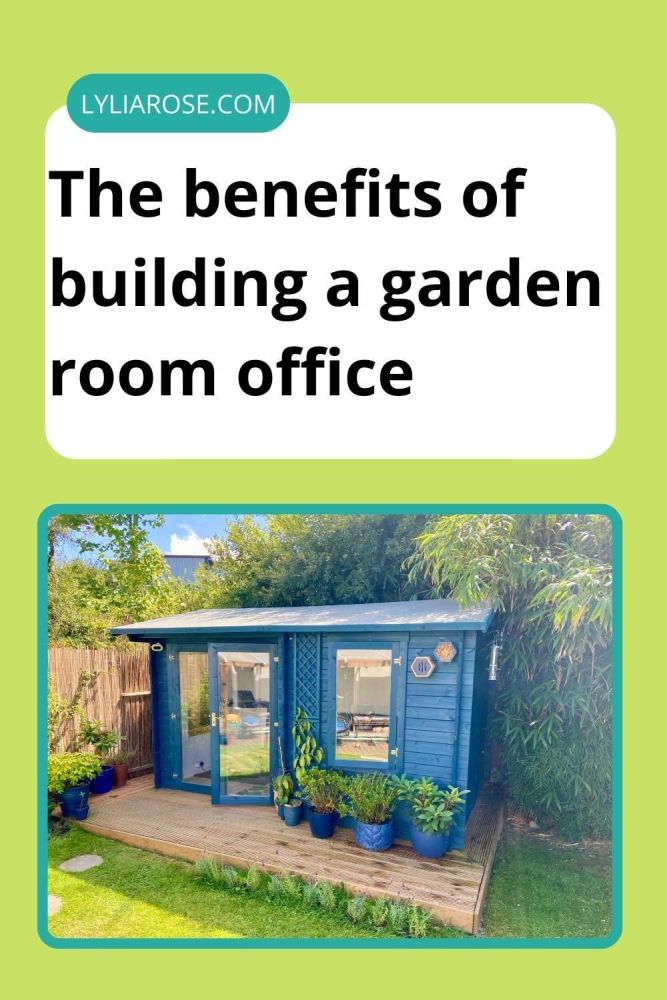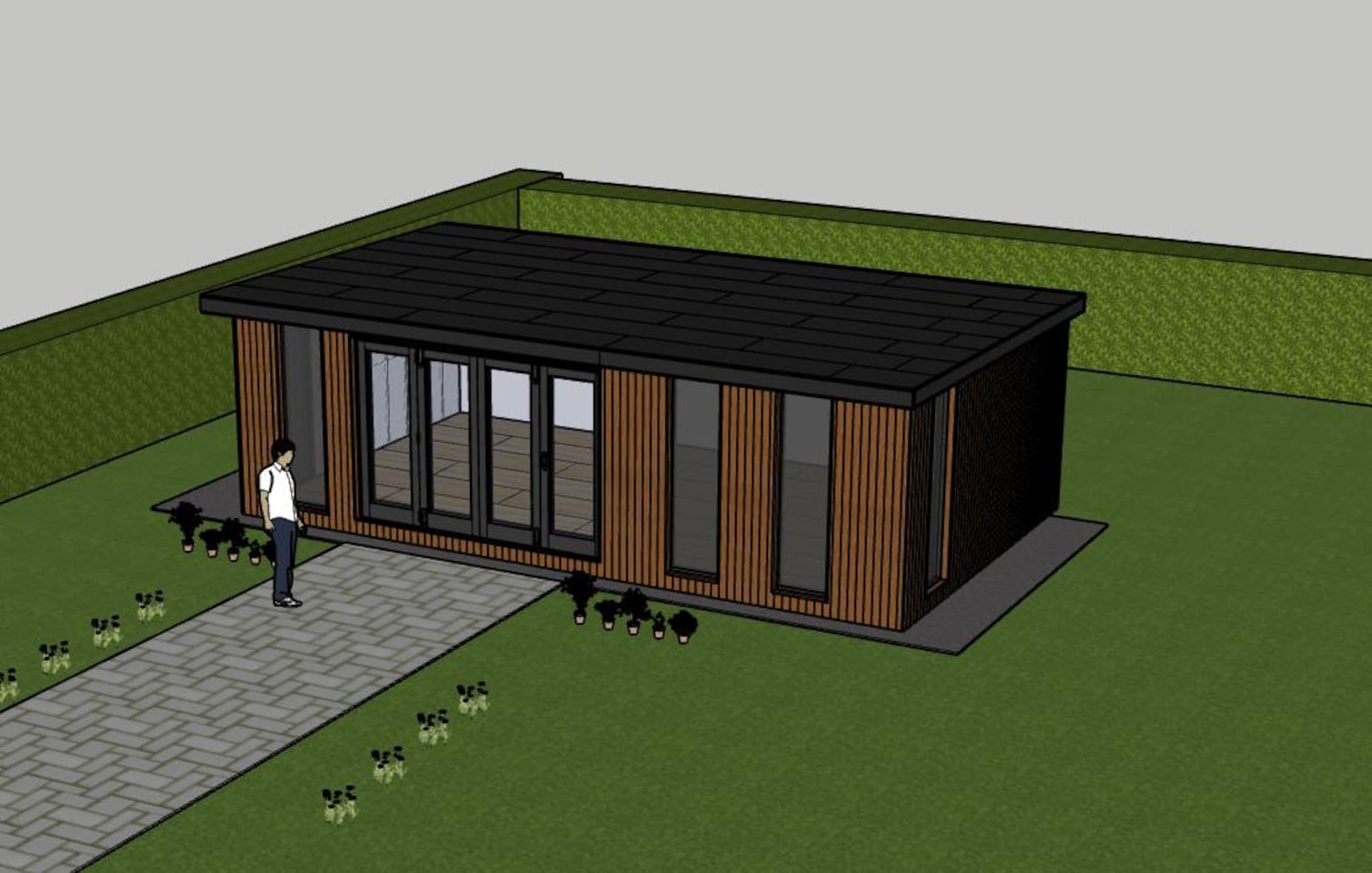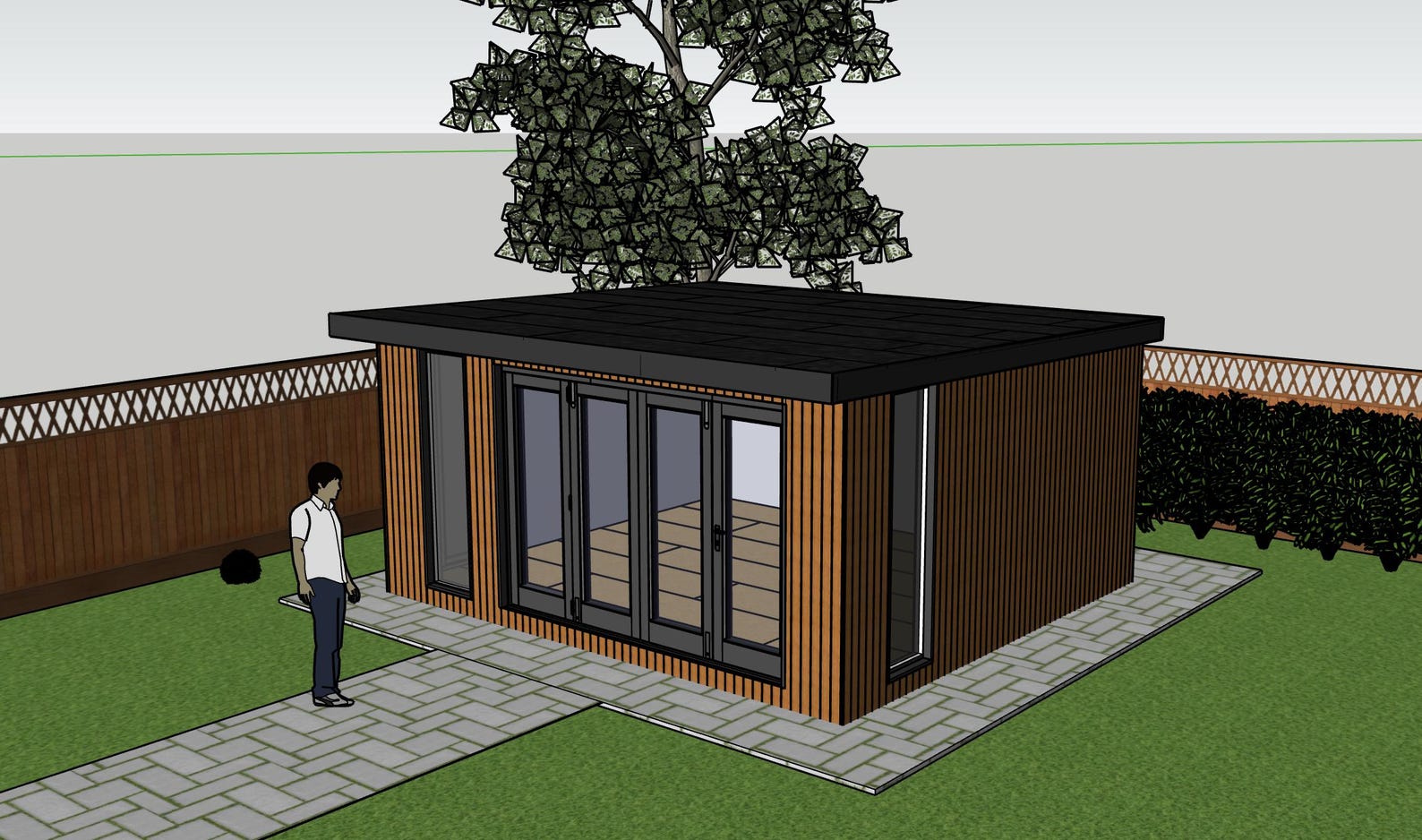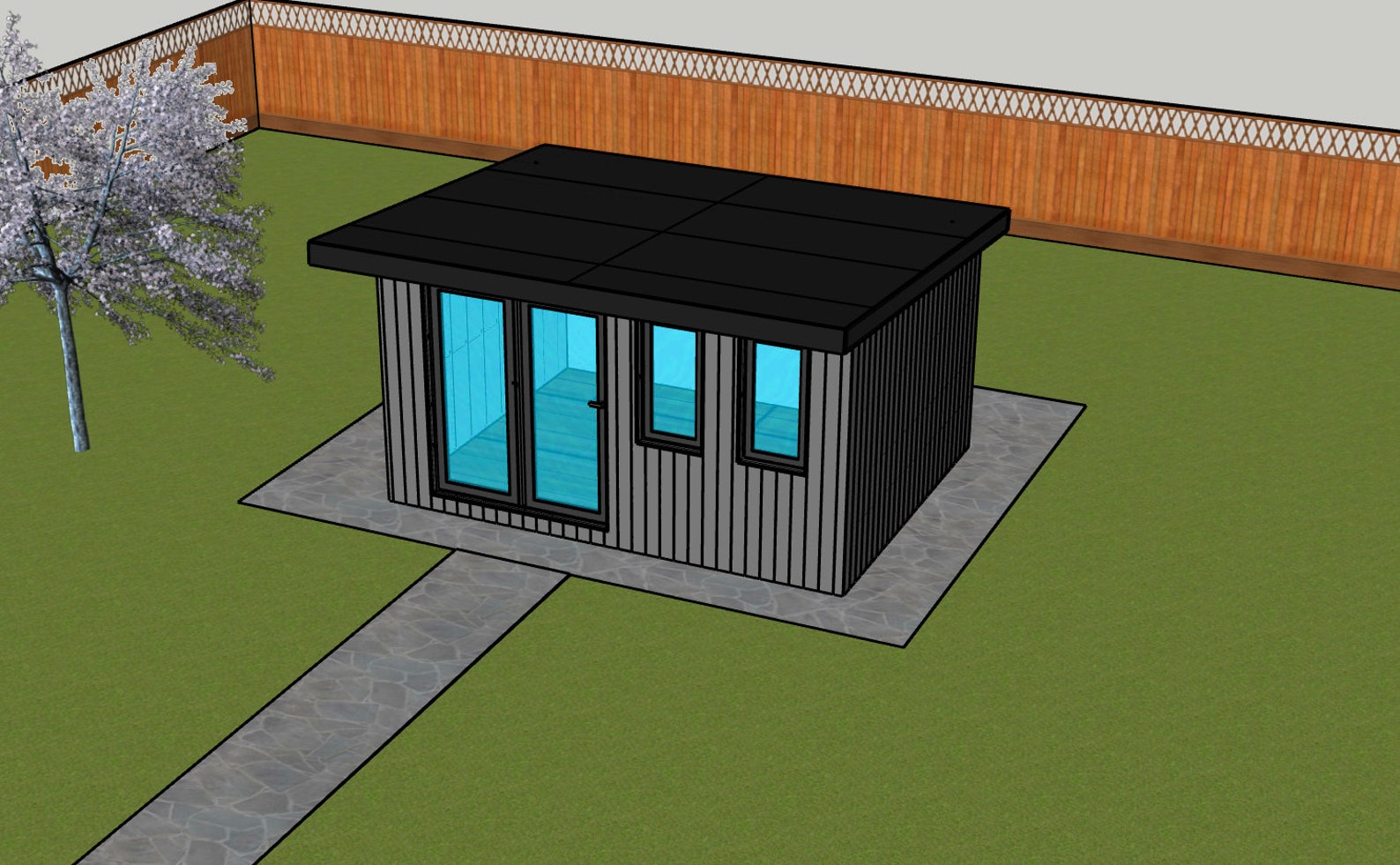The Benefits of Building a Garden Room Office
Posted on
Working from home is the dream scenario for many people, but if that dream becomes a reality, where will you work from?
Unless you have a dedicated room that can be used as a home office, you will be working quite literally from your dining table or squeezing a desk into a shared space.
So here's the important question: is it worth building a garden office?

It’s not always ideal to have to share space, especially if you have young children running around your feet when you need to work. I’m talking from experience, as my office space was shared with the playroom for my children. We were very lucky to have the space for me to fit a desk into, but if I needed to work when the children were home, then it became challenging.
Luckily, we've now had the opportunity to build our very own garden office. Whilst we had room within our home to create a dedicated workspace, we wanted something separate from the hustle and bustle of the busy family home.
In this blog post, I am going to explore the pros and cons of building a garden room office.

8×5m (26x16ft) Garden Room Plans + 3D Model – Full Build Instructions, Insulated Garden Office PDF
PROS: The benefits of a garden room office
In this next section, I'm going to share the benefits of having a dedicated workspace in your garden.
Less hassle than an extension
Whilst an extension might be the first obvious choice, it comes with a lot more upheaval than garden rooms do. Not only do you need suitable space on your existing property for an extension, but you’ll also need foundations dug, planning permission, building regulations, and the building itself could take weeks, as well as be very costly.
Plus, you’ll have all that noise, dust and inconvenience right where you are living and working. It might not be ideal.
In comparison, a garden room might be built away from the house, disrupting your actual home very little. A build can take as little as two weeks. Planning laws are more relaxed, and many garden offices will fall under permitted development, meaning you won’t need to gain permission so long as it’s less than 2.5 metres high and takes up no more than 50% of the back garden.
Cost is another consideration that falls under this heading. An extension will cost a minimum of £15,000 due to the complex construction methods used. Garden offices will cost a fraction of this. Whilst prices will start from around the £3,000 mark, our fully insulated 4m x 3m garden office costs just under £6,000. (Costs based on a DIY build, materials only in 2022.)
If you’re weighing up an extension versus a garden office, think about disruption as well as cost. An extension means builders in your living space, dust, noise and weeks of upheaval. A garden office keeps most of the mess outside and the work contained.
Many homeowners also find that insulated garden rooms in the UK are one of the most cost-effective ways to add usable space, especially now so many of us work remotely. If you’re trying to decide, list what you need the space to do, how soon you need it, and how much disruption you can live with. The answer usually becomes obvious.
Enjoy the summer weather
There’s nothing worse than being cooped up in an office all day long when the weather is glorious outdoors. A garden office with open bi-folding doors, or even just open French doors, will make you feel more connected to your garden and outdoor space and less like you are trapped in a stuffy office.
Garden offices tend to have plenty of windows and doors that let light flood into the space. This presents a feeling of being outdoors, which can be great for the body and mind, especially when you are spending extended periods in front of a screen.
Natural light isn’t just nice to have; it helps your body clock, mood and focus. A well-placed garden office with generous glazing can cut daytime lighting needs and make you feel more connected to the outdoors.
If you want to go further, think about cross-ventilation, overhangs to shade the hottest midday sun, and blinds that soften glare on screens. These simple details make a small space feel calm and comfortable through the seasons.
Furnishing the office of your dreams
Your garden room can be decorated however you please. Most office spaces will benefit from suitable office desking and chairs, but you also have the option to add more. Depending on the size and planned use of the space, you might want to add a sofa, gym equipment or a reading nook.
Some might use this space for a therapy or treatment room where customers visit. This then requires more specialised furniture to suit the specific industry. Salons, massage, hairdressing and other occupations can all be hosted in a garden office.
We decided to make our garden room a multi-purpose space. Somewhere to work, relax and exercise, which is why we have a large desk, a two-seater sofa and a treadmill. It's the perfect spot to escape the busy household life.
We chose to have the walls professionally plastered and could have done the same with the ceiling, but we decided to keep a natural theme with strips of wood instead. We added a thermal underlay for the flooring to help soundproof and retain heat in the outdoor office, with engineered wood flooring on top. By adding high-quality flooring and plastering the walls, it really does create a 'real' office that feels like a room of the house and not just a garden shed!
Multi-purpose wins in a compact footprint. Choose a desk that actually fits your workflow, then build around it: a supportive chair, a quiet lamp, a soft rug to absorb sound. Add one comfort piece you genuinely use — a small sofa, a reading chair, or a fold-flat treadmill.
Storage matters too. Shallow shelves keep things within reach without eating up the room. Hidden cable trays and a few well-placed hooks stop visual clutter, which makes the whole space feel more grown-up than “shed”.

No need to take up valuable space inside
One of the greatest benefits is not having to sacrifice space inside the home for a home office. You can keep your home exactly as it is and create another room outdoors instead. Of course, there are many genius solutions to create a small home office if you have to create something inside the home, but if you have the funds and garden space, then a garden office is the perfect solution.
Versatility is the hidden benefit. A garden office can double as a creative studio, a quiet revision room for teens, or a guest space with a fold-out bed if you plan it thoughtfully. Modular furniture helps; so do neutral walls and a warm floor that make the room feel like part of the home rather than an outbuilding. When life changes, the room adapts.
30-second commute
Of course, some people have absolutely no room in the house for a suitable workspace, so they will instead hire an office space or frequent cafes and Wi-Fi spots. Not only can this begin to add up in rental fees and daily coffee expenses, but there is also the cost and time needed to travel to a different location. By investing in a garden room as an office, you’ll have a 30-second commute, no rent to pay and much cheaper hot drinks!
Time saved is energy saved. Cutting the commute gives you back minutes that add up to hours each week — time you can put into deep work, a lunchtime walk, or even finishing early for the school run. Fewer paid coffees, fewer train fares, less faff. It’s surprising how quickly those small savings help justify the build.
Have it your way
You can decorate your office with the decor you want and love. You can personalise the space and get away from the dull grey office walls and cubicles that lack any consideration for design and comfort. What's more, you no longer have to battle and debate with coworkers over the air conditioning and temperature settings. Just have it your way.
Comfort drives focus. If you’re on calls, consider a bit of acoustic treatment: a rug, curtains, a bookcase wall, even a few felt panels. For lighting, aim for layers — warm overhead light, a task lamp at the desk, and a softer corner lamp for late afternoons. Add plants for texture and a calmer feel. These are little upgrades that make the space somewhere you want to spend time.

5×4m (16x14ft) Garden Room Plans + 3D Model – Full Build Instructions, Insulated Garden Office PDF
Better work-life balance
One of the trickiest parts of working from home is being able to separate work and life. It’s possible to work all the time, and you can never leave work at work because you’re always technically at work! It’s a dilemma!
By creating a garden office that can be locked shut and forgotten about when you are back in your home, you can create a real sense of division and keep your home simply as your home. Having an office away from the house will create a better work-life balance and a clear mental separation.
Physical separation creates mental separation. When you lock the door and walk back into the house, your brain gets a clear signal that work is done. That one habit helps reduce evening laptop creep, lowers stress and improves sleep. A simple closing routine helps too — tidy the desk, note tomorrow’s top three tasks, shut down properly. You’ll start the next day fresher.
Away from distractions
As well as creating a better work-life balance, it will also help to create a more productive work environment. As much as it’s tricky to switch off from work if you work at home, it’s equally as challenging to switch off from the housework when you are meant to be working! Being at home all day means you are surrounded by chores that need doing, and it can be hard to let them go when they are right there in front of you.
Creating a garden office gives a space that is for work only and allows the mind to switch off from any other distractions. It also means there is a place to work that is away from partners and children to allow for greater concentration if work needs to be completed when the family are at home.
A dedicated workspace helps you design your day. Set working hours, silence non-essential notifications, and keep only work items in the room. If the family are home, agree on signals — a door sign or a lamp on the desk that means “heads down time”. Small boundaries make big gains in concentration.

4.2x3m (14x10ft) Garden Room DIY Plans: Detailed Build Guide (Metric)
Save money in the long run
The initial upfront costs of a garden office might seem quite high for some, but it works out much cheaper in the long run. On average, hiring office space in the UK can cost around £520 per person per month in a dedicated space or £270 per month in a coworking space. This cost can quickly add up over time. Sometimes it's better to invest in your own property and build a garden office. You could pay for a £6,000 garden office in less than a year at the same price as a dedicated workspace.
Are garden rooms a good investment? Simply put, yes, they are, as you're adding value to your property, and the overall build cost will pay for itself within 1-2 years from the money saved in rent. There are many great ways to use a garden room, such as an office, but if you come to sell your house, the new owners can use the room however they please, as an extension of their living space if they don't need an office.
Think total cost of ownership. Yes, there’s an upfront spend, but compare it with renting a desk or office over two to three year,s and the numbers often swing in favour of building. Insulation quality matters here: better insulation lowers ongoing heating costs and makes the space usable year-round. Many owners also see a property value uplift when the office is well built, well insulated and looks like a natural extension of the garden design. And if you ever change how you work, the room still holds value as a gym, studio or hobby space.
It's an eco-friendly option
No commute equals a lower carbon footprint, and when you invest in an insulated garden office, your energy bills will be lower than in an air-conditioned office. Many garden offices will also be available with sustainable or recycled materials in mind, so the environmental construction impact should be minimal.
Lower travel, lower energy, lower noise. Choose responsibly sourced timber, recycled insulation where it performs well, and efficient glazing. Plan shading, ventilation and smart heating so the room stays comfortable with minimal power. An “eco” build is often just a series of sensible choices that pay you back in comfort and lower bills.
CONS: The disadvantages of building a garden room office
There are plenty of benefits mentioned here, but I'd like this to be an unbiased article. Therefore, I should talk about some of the cons of building an office in your garden. Whilst the pros outweigh the cons, let's quickly take a look at what might not be so good about your own garden office.
Upfront costs
Garden buildings can be expensive. Yes, you can keep the construction costs down, but you'll need your building to be fit for purpose. You'll need electricity, a solid watertight construction, insulation, lighting and furniture, which can all add up. If you work in a specific sector and need specialist equipment, this can also add up. Yes, you'll save money in the long run, but the initial upfront costs are quite high.
You should also check whether you need permission to run your business from home, as it's not suitable for some industries, and you don't want to waste money building a workspace if your neighbours complain.
Budget beyond the shell. Include a proper base, electrical connection, consumer unit, heating, insulation, lighting, flooring and furnishings. Add a contingency — 10 to 15 per cent is realistic — for price changes or small upgrades you’ll inevitably want once you’re in. If cash flow matters, a phased approach can work: prioritise structure and insulation first, then add non-essentials over time.
Heating and cooling
Heating and cooling your office needs to be a primary consideration. If you are spending a lot of time there, you want to be comfortable. Electric heating is expensive, especially in the height of winter when temperatures can drop to below freezing.
Cooling the office can also be a challenge during heat waves. Luckily, we don't get many of these in the UK, but air conditioning units can be a sensible option for times like this. We got away with a desk fan this summer with the windows open.
Ensuring your office is properly insulated should be high on the agenda during construction. The thicker the insulation, the better the protection. We opted for a 25mm thick insulation board in our office, which is OK, but I would recommend getting 50mm or even 100mm where possible. Insulation will not only keep the heat in during winter, but during the summer it will also keep the heat out.
Plan climate control at the design stage. A small, efficient panel heater with a thermostat can handle winter in a well-insulated office. In summer, cross-breezes, blinds, and a low-noise fan go a long way; a compact air-con unit is a backup for heatwaves. Upgrade insulation thickness if you can — it’s the one thing that’s hard to change later and makes the biggest comfort difference.
You're still at home!
Whilst you have a bit of separation from home life, it's not completely gone. Interruptions will still occur in the form of children, deliveries, husbands and wives, so you don't have that 100% escape. If you're anything like me, you'll also have the looming thought of washing up, laundry and general household cleaning playing on your mind. Sometimes you just need to get out and completely away from home life and distractions!
Build in a few habits to protect focus. Set “office hours”, batch home tasks outside those times, and use a simple door sign to avoid constant knocks. If interruptions happen — deliveries, kids, life — reset quickly with a short stretch, a glass of water and a note of what you were doing. It stops small breaks from turning into lost afternoons.
Conclusion on the benefits of a garden room office
There are so many benefits a garden office can bring, from a more productive work day to a better work-life balance. Yes, you'll need that up-front investment, but think about the potential long-term savings. You won't be completely separate from your household and interruptions, but if you can manage these carefully, you'll have a highly productive environment and privacy in the garden where you can focus on your daily tasks.
If you’re asking “are garden offices worth it?”, the honest answer is: it depends on how you’ll use it and how well it’s built. If you work from home even part-time, value quiet focus, and want flexible space that can evolve with your life, a thoughtfully designed garden office pays you back in productivity, balance and long-term value.
Want to make some extra cash?
- To get started, you can make money online with 60 methods I’ve tried and tested.
- Just need £1000? Here’s how to make £1000 in one month at home.
- Short on time? These methods can make money in one hour.
- Want free cash? Here are loads of free money offers.
- Subscribe to my free money newsletter for the best free money offers, money-making and money-saving tips we discover!


